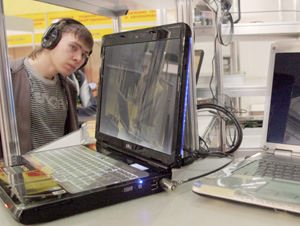Why can’t Ukrainian institutions of higher education compete with foreign ones?
Microsoft Ukraine inspires reforms in the country’s higher education system
An unprecedented event took place in Kyiv last week: over 100 leading Ukrainian institutions of higher education gathered at the first higher education summit in order to discuss the plans for their future development. An emphasis was placed on the new approaches to higher education management, which certainly have to be linked to innovative technologies. Specialists opine that innovative computer technologies are the basis of success and competitiveness for any institution of higher education and the experience of leading universities confirms this. Unfortunately, at present, Ukrainian institutions are far from being able to compete with international ones.
“The top ten most competitive universities certainly comprise two European ones (Oxford and Cambridge universities). The Moscow State University is at the 74th place out of 100, and Ukrainian institutions of higher education didn’t enter even the top thousand,” states the Microsoft manager for cooperation with educational institutions in Central and Eastern Europe Sandis Kolomenskis. “I wonder why the universities of Oslo or Helsinki are better than Shevchenko University? The first reason for this is the insufficient funding. For instance, the annual budget of Stanford University is 3.5 billion dollars for 15,000 students. Of course, the budget may be the main argument, but Ukraine has to think it over so as not to lose talented students and scientists. Every year about 6,000 scientists leave Ukraine, which is the great number.”
HOW CLOUD COMPUTING WORKS
According to the experts, the reform and modernization of institutions of higher education (and attracting the new personnel, accordingly) greatly depends on the synergy created by innovative technologies. How does this work? Owing to these technologies communication between the university, students, teachers and business is significantly improved. It also makes it easier to find talented people and work with them.
One example is Washington University. Owing to Microsoft technologies, namely Microsoft Live@edu, this university saves up to 100,000 dollars per year. Twenty-five thousand students, 1,300 teachers and 4.3 thousand admin people use the program. Live@edu enables the university and its students to cooperate, exchange messages and provides cloud services for file storage. All these facilities are being constantly improved and the cost of such services isn’t high.
The next story concerns the Caribbean. After the destructive earthquake that killed hundreds of thousands of people, the Haiti Information Technologies High School implemented the Microsoft Multipoint Server technology that allows several students to work at the same computer simultaneously. This way the high school has increased the number of working places at almost no additional cost, lowered energy consumption and reduced working place expenditures by half.
These are only two examples of cloud computing-based technologies that allow one to solve more problems quicker and for less money.
TALENTED PEOPLE NEED THE MOST INVESTMENT
The higher education summit also presented cloud computing-based educational services: Live@edu, Microsoft Azure Platform, Windows MultiPoint Server 2011, automatic systems for testing students, communication technologies that greatly reduce costs, portal services based on SharePoint and others.
“Now it’s difficult to imagine an institution of higher education without corresponding technical equipment. Unfortunately, today most Ukrainian universities see the money spent on information technologies as expenses and not investments. The educational process doesn’t respect intellectual property. However, innovative technologies increase the efficiency of any institution of higher education. The Live@edu initiative, and communication and portal services are probably the most needed technologies offered by Microsoft in the education sector. It’s very good to see that our expertise in building up competitive Ukrainian universities brings positive results, which are felt not only by students but also by the universities’ management,” said the manager for cooperation with scientific and educational institutions of Microsoft Ukraine Oleksandra Syzova.
The Russian State Trade and Economic University shared its experience in implementing cloud technologies. In Ukraine they’ve only started to introduce such new approaches, notably at the National Academy of Public Administration and the Donetsk National University of Economics and Trade.
“The implementation of the new communication technologies found in Microsoft Office Communications Server and Live@edu has given more possibilities for information exchange and the possibility to significantly save the time of the personnel and students, as well as the university’s coffers,” said the director of the Institute for Information Technologies at the Donetsk National University of Economics and Trade Valerii Solohub.
Specialists emphasize that innovative technologies are investments that are quickly compensated for and that help save considerable amounts of money. The most money must be invested in talented people, ideally headhunted by universities.
“People are the most valuable resource. We have to invest in them. If we want to go beyond Ukraine we have to pay attention to what is most in demand in the world. We won’t get anywhere if we compete with domestic universities. We have to compete for foreign students,” emphasized Syzova.
One more issue that can’t be overlooked when speaking about the development of education is the role of business. Specialists remind that education can only become competitive if there is a dialog between the institutions of higher education, the state and business.






